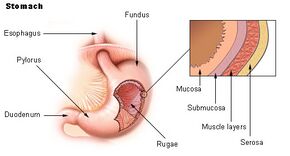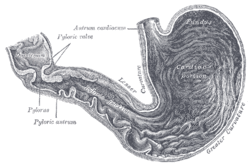Biology:Gastric folds
| Gastric folds | |
|---|---|
 Stomach | |
| Details | |
| Identifiers | |
| Latin | plicae gastricae |
| Anatomical terminology | |
The gastric folds (or gastric rugae) are coiled sections of tissue that exist in the mucosal and submucosal layers of the stomach.[1] They provide elasticity by allowing the stomach to expand when a bolus enters it. These folds stretch outward through the action of mechanoreceptors, which respond to the increase in pressure.[2] This allows the stomach to expand, therefore increasing the volume of the stomach without increasing pressure.[2] They also provide the stomach with an increased surface area for nutrient absorption during digestion.[2] Gastric folds may be seen during esophagogastroduodenoscopy or in radiological studies.[3][4]
Layers
The gastric folds consist of two layers:
- Mucosal layer - This layer releases stomach acid. It is the innermost layer of the stomach.[5] It is affected by the hormone histamine, which signals it to release hydrochloric acid (HCl).
- Sub-mucosal layer - This layer consists of different vessels and nerves, ganglion neurons, and adipose tissue. It is the second layer of the stomach and supports the mucosa.[6]

Clinical significance
Thickening of the gastric folds may be observed by endoscopy or radiography and may aid in the differential diagnosis of many disease processes including:[3]
- Gastritis
- The folds become very thick due to inflammation.[7]
- Peptic ulcer disease
- Ulcers cause breaks in the mucosa and cause erosion of the sub-mucosa.
- Zollinger-Ellison syndrome
- Gastrin levels increase due to tumors, which cause an increase in the gastric fold size.[7]
- Ménétrier's disease
- The mucosa pits are in excess causing thickening of the folds.[7]
- Carcinoma
- Helicobacter pylori infection
- Causes inflammation of the folds.
- Gastric syphilis[8]
- Cytomegalovirus
- Mucosa change shape causing rugae enlargement.[9]
- Sarcoidosis
- Causes thickening of the folds.
References
- ↑ David., Shier (2009). Hole's essentials of human anatomy & physiology. Butler, Jackie., Lewis, Ricki. (10th ed.). Boston: McGraw-Hill Higher Education. pp. 421. ISBN 978-0077221355. OCLC 171614173.
- ↑ 2.0 2.1 2.2 Michelle., McGuire (2013). Nutritional sciences : from fundamentals to food. Beerman, Kathy A. (3rd ed.). Belmont, CA: Wadsworth, Cengage Learning. pp. 90. ISBN 978-0840058201. OCLC 786272310.
- ↑ 3.0 3.1 L., Eisenberg, Ronald (2003). Gastrointestinal radiology : a pattern approach (4th ed.). Philadelphia: Lippincott Williams & Wilkins. pp. 223–236. ISBN 978-0781737067. OCLC 49550593.
- ↑ "The Stomach and Its Role in Digestion" (in en). https://www.laparoscopic.md/digestion/stomach.
- ↑ Taylor, Tim. "Stomach". http://www.innerbody.com/image_digeov/dige11-new.html.
- ↑ "Stomach". http://wwwmgs.bionet.nsc.ru/mgs/gnw/trrd/thesaurus/Di/stomach.html.
- ↑ 7.0 7.1 7.2 "Gastritis, Giant Hypertrophic - NORD (National Organization for Rare Disorders)". https://rarediseases.org/rare-diseases/gastritis-giant-hypertrophic/.
- ↑ Butz, William; Watts, John; Rosales-Qiuntana, Sergio; Hicklin, Martin (1975). "Erosive Gastritis as a Manifestation of Secondary Syphilis". American Journal of Clinical Pathology 63 (6): 895–900. doi:10.1093/ajcp/63.6.895. PMID 1096590. https://academic.oup.com/ajcp/article-pdf/63/6/895/5002315/ajcpath63-0895.pdf. Retrieved 9 December 2017.
- ↑ Dughera, Francesca; Baino, Sara. "Cronkhite-Canada Syndrome" (in en). http://flipper.diff.org/app/items/6630.
 |

